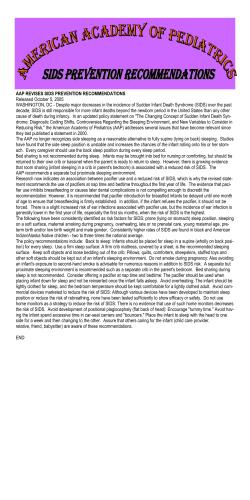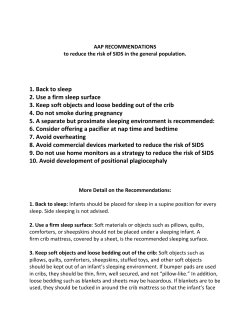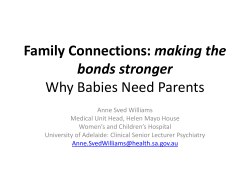
Document 69784
Guideline [Optional heading here. Change font size to suit] Document Number # QH-GDL-362:2013 Safe Infant Sleeping, Co-sleeping and Bed-sharing 1. Purpose This Guideline provides recommendations regarding best practice in relation to safe infant sleeping, co-sleeping and bed-sharing. This Guideline is provided to assist Hospital and Health Services in the development of their own clinical practice policies, procedures and guidelines. The intent of this Guideline is to reduce the risk of SUDI through consistent education of parents; training of health professionals/providers; and implementation of safe infant sleeping recommendations in Hospital and Health Service facilities. 2. Scope This Guideline provides information for all Department of Health employees (permanent, temporary and casual) and all organisations and individuals acting as its agents (including partners, contractors, consultants and volunteers). 3. Related documents Procedures, Guidelines and Protocols: Statewide Clinical Pathway (Neonatal, Caesarean and Vaginal Births) Queensland Maternity and Neonatal Clinical Guideline: Breastfeeding Initiation Forms and templates: Pregnancy and Personal Health Records 4. Guideline for Safe Infant Sleeping, Co-sleeping and Bed-sharing 4.1 Principles Health services are informed by evidence-based national safe infant sleeping recommendations. Health services apply a continuous quality improvement approach to their performance, promotion of safe infant sleeping messages and evaluation of practice. Safe infant sleeping promotion, co-sleeping and bed-sharing messages are delivered consistently across the continuum of health services by ensuring health professionals/providers have access to evidence-based training and resources. Version No.: <no> Version No.: <no> ; Effective From: <date> ; Effective From: <date> Version No.: 1.0 Page 1 of 7 Page 1 of 7 Effective From: 1 July 2013 Page 1 of 7 Department of Health: Safe Infant Sleeping, Co-sleeping and Bed-sharing 4.2 Safe sleeping 4.2.1 All health professionals/providers handling infants should ensure a safe sleeping environment by12: sleeping baby on their back from birth, not on their tummy or side (unless medically indicated and documented). sleeping baby with head and face uncovered (place feet to foot of cot if sleeping in a cot; no head coverings including hats, bonnets, beanies for sleep). keeping baby smoke free before and after birth. providing a safe sleeping environment night and day (safe cot, safe mattress, safe bedding; no bonnets, doonas, loose bedding or fabric, pillows, lambs’ wool, bumpers or soft toys). sleep baby in their own safe sleeping place in the same room as an adult care-giver for the first six to twelve months. promoting and supporting breastfeeding from birth. 4.2.1 All health professionals/providers should ensure safe infant sleeping messages are clearly visible on cots card, wall signs etc. 4.3 Co-sleeping and Bed-sharing 4.3.1 All health professionals/providers should explain the safety measures, benefits and contra-indications to co-sleeping and bed-sharing to the mother and partner/support person (where present), and document this in the mother’s medical record. 4.3.2 If a mother chooses to co-sleep or bed-share, all health professionals/providers should document this in the mother’s medical record. 4.3.3 All health professionals/providers should ensure safe infant sleeping messages are clearly visible on cots card, wall signs etc. 1 Mitchell EA, Freemantle J, Young J, Byard RW (2011) Scientific consensus forum to review the evidence underpinning the recommendations of the Australian SIDS and Kids Safe Sleeping Health Promotion Programme - October 2010. Journal of Paediatrics and Child Health Article first published online: 3 NOV 2011, DOI: DOI: 10.1111/j.14401754.2011.02215.x 2 Fern R. Hauck, John M. D. Thompson, Kawai O. Tanabe, Rachel Y. Moon and Mechtild M. Vennemann. Breastfeeding and Reduced Risk of Sudden Infant Death Syndrome: A Meta-analysis. Pediatrics 2011;128;103; originally published online June 13, 2011; DOI:10.1542/peds.2010-3000 Version No.: 1.0; Effective From: 1 July 2013 Page 2 of 7 Department of Health: Safe Infant Sleeping, Co-sleeping and Bed-sharing 4.4 Conducting assessments and supervision in health facilities 4.4.1 All health professionals/providers should conduct assessments of smoking, alcohol and other drugs behaviour as part of routine antenatal, postnatal and community contacts. 4.4.2 All health professionals/providers should ensure a risk assessment is completed for every mother and infant when bed-sharing and cosleeping occurs to determine the level of supervision required. 4.4.3 All health professionals/providers should ensure the outcome of the assessment is documented in the mother’s medical records at least once per shift, or as often as clinically indicated. 4.4.4 All health professionals/providers should discuss the level of risk with the mother and partner/support person (where present), and take measures to ensure that the physical environment is as safe as possible. 4.4.5 All health professionals/providers should ensure when handing care to another member of the team that they are made aware of the information provided to the mother, partner or support person in accordance with the above, outcomes of the risk assessment as above, and actions taken/level of supervision required. 4.5 Educating parents3 4.5.1 All health professionals/providers should ensure that prior to discharge all parents are directly provided with safe infant sleeping recommendations. 4.5.2 All health professionals/providers should ensure that prior to discharge the following is discussed with all parents regardless of whether the mother has shared a sleep surface with her infant in hospital: the risks of bed-sharing/co-sleeping if either parent is a smoker, has consumed alcohol or taken drugs which alter consciousness or cause drowsiness the risks of bed-sharing when tired the dangers of sleeping with an infant on a sofa, waterbed, bean bag or a sagging mattress the risks of letting an infant sleep alone in an adult bed the risks of letting an infant sleep with other children or pets 3 A suite of safe infant sleeping brochures, posters and information for parents is available through the SIDS & Kids website at http://www.sidsandkids.org The SIDS & Kids website is an allowed website meaning all staff are authorised to access this information. Version No.: 1.0; Effective From: 1 July 2013 Page 3 of 7 Department of Health: Safe Infant Sleeping, Co-sleeping and Bed-sharing the importance of ensuring the infant does not overheat whilst bedsharing. 4.5.3 All health professionals/providers should document the provision of information in medical records, e.g clinical pathway, medical record of mother, medical record of infant. 4.5.4 All health professionals/providers should ensure that the benefits and the risks of co-sleeping and bed-sharing are discussed with all mothers in the antenatal period and again in the early post-natal period up to 12 months of age in accordance with the above information 4.5.5 All health professionals/providers in the antenatal, hospital, community and primary health care settings shall ensure that safe infant sleeping recommendations are: made available to all parents of infants under 12 months of age accessible age appropriate culturally appropriate easily understood. 4.6 Health Professional/Provider training4 4.6.1 Nursing/Midwifery/Medical Directors should provide health professionals/providers with opportunities to maintain their clinical skills and knowledge of evidence-based parenting advice on safe infant sleeping best practice, and co-sleeping and bed-sharing practices. 4.6.2 All health professionals should maintain their clinical skills and knowledge of evidence-based parenting advice in safe infant sleeping best practice, and co-sleeping and bed-sharing practices. 4.6.3 Nursing/Midwifery/Medical Directors should incorporate safe infant sleeping recommendations (detailed above) in the induction and orientation of any volunteer handling infants. 4 A suite of safe infant sleeping educational resources for health professionals/providers is available through the SIDS & Kids website at http://www.sidsandkids.org. The Safe Infant Sleeping E-learning Program is available through Queensland Health’s Clinical Skills Development Service website at www.sdc.qld.edu.au/e-learning.php. The SIDS & Kids website is an allowed website meaning all staff are authorised to access this information. Version No.: 1.0; Effective From: 1 July 2013 Page 4 of 7 Department of Health: Safe Infant Sleeping, Co-sleeping and Bed-sharing 5. Review This Guideline is due for review on: 1 July 2015 Date of Last Review: N/A Supersedes: Safe Infant Sleeping Policy (QH-POL-362); Co-sleeping and Bed-sharing Implementation Standard (QH-IMP-362-1); and Safe Infant Sleeping Implementation Standard (QH-IMP-362-2) 6. Business Area Contact Strategic Policy Priority Areas, Policy and Planning Branch, System Policy and Performance Division 7. Definitions of terms used in the policy and supporting documents Term Bed-sharing Definition / Explanation / Details Bed-sharing refers to bringing baby onto a sleep surface when cosleeping is possible, whether intended or not. Source UNICEF Leaflet “Sharing a bed with your baby” (June 2005) available at www.babyfriendly.org.uk/pdfs/sharingbedleaflet.pdf UNICEF U.K. Baby Friendly Initiative (2004). Babies sharing their mothers’ bed while in hospital: A sample policy. UNICEF UK Baby Friendly Initiative, London. Co-sleeping Co-sleeping may be defined as a mother and /or her partner (or any other person) being asleep on the same sleep surface as the baby. UNICEF Leaflet “Sharing a bed with your baby” (June 2005) available at www.babyfriendly.org.uk/pdfs/sharingbedleaflet.pdf UNICEF U.K. Baby Friendly Initiative (2004). Babies sharing their mothers’ bed while in hospital: A sample policy. UNICEF UK Baby Friendly Initiative, London. Environmental tobacco smoke (ETS) Refers to smoke from the end of a lit cigarette or breathed out by a smoker. Centre for Community Child Health (2006) Preventing Passive Smoking Effects on Children: Practice Resource. Victorian Government: Centre for Community Child Health. Fatal sleeping Accident Is a death occurring during sleep, as a result of an accident, such as a fall, or suffocation, or mechanical asphyxiation. Fatal sleeping accidents are explained deaths that meet SUDI criteria. One who diagnoses and/or treats physical and mental illnesses and conditions, and recommends, administers, dispenses and develops medications or treatments to promote, restore or manage good health. Commission for Children and Young People and Child Guardian Queensland (2007) Annual Report: Deaths of children and young people, Queensland 2006-07. Commission for Children and Young People and Child Guardian Queensland, Brisbane. Health professional Version No.: 1.0; ACT Government Health Directorate http://health.act.gov.au/professionals/alliedhealth/salary-information Effective From: 1 July 2013 Page 5 of 7 Department of Health: Safe Infant Sleeping, Co-sleeping and Bed-sharing Term Health provider Definition / Explanation / Details Refers to any person or organisation that is involved in or associated with the delivery of healthcare to a client, or caring for client wellbeing. Source Australian Government (2008) Australian Institute of Health and Welfare. Passive smoking Refers to breathing tobacco smoke in the environment. Centre for Community Child Health (2006) Preventing Passive Smoking Effects on Children: Practice Resource. Victorian Government: Centre for Community Child Health available at www.rch.org.au/ccch Room sharing Refers to sleeping the baby in a cot or other separate sleeping surface in the same room as the parents. SIDS and Kids (2008) Information Statement: Room-sharing. September, 2008. Melbourne: SIDS and Kids available at http://www.sidsandkids.org.au Sharing the same sleep surface Includes the practices of bed-sharing and co-sleeping on the same sleep surface. This terminology allows differentiation of the risks associated with solitary sleeping (baby sleeping in a separate room), room-sharing and environments in which the baby and caregiver share the same sleep surface. Sudden Infant Death Syndrome (SIDS) is defined as “the sudden and unexpected death of an infant under one year of age, with onset of the lethal episode apparently occurring during sleep, that remains unexplained after a thorough investigation including performance of a complete autopsy and review of the circumstances of death and the clinical history’’. SIDS and Kids (2007) Information Statement: Sleeping with a baby. September, 2007. Canberra: SIDS and Kids available at http://www.sidsandkids.org.au SUDI is the sudden, unexpected death of an infant usually occurring during sleep, in which the cause is not immediately obvious. SUDI includes Sudden Infant Death Syndrome (SIDS) and fatal sleeping accidents. Commission for Children and Young People and Child Guardian Queensland (2007) Annual Report: Deaths of children and young people, Queensland 2006-07. Commission for Children and Young People and Child Guardian Queensland, Brisbane. SIDS SUDI Version No.: 1.0; http://meteor.aihw.gov.au/content/index.phtml/itemI d/356020 SIDS and Kids website available at http://www.sidsandkids.org/ Commission for Children and Young People and Child Guardian Queensland (2007) Annual Report: Deaths of children and young people, Queensland 2006–07. Commission for Children and Young People and Child Guardian Queensland, Brisbane. Krous H, Beckwith J, Byard R, Bajanowski T, Corey T, Cutz E, Hanzlick R, Keens T, Mitchell, E. (2004) Sudden infant death syndrome and unclassified infant deaths: a definitional and diagnostic approach. Pediatrics 114(1): 234-238. Effective From: 1 July 2013 Page 6 of 7 Department of Health: Safe Infant Sleeping, Co-sleeping and Bed-sharing 8. Approval and Implementation Policy Custodian: Senior Director, Policy and Planning Branch, Policy, System Policy and Performance Division. Responsible Executive Team Member: Deputy Director-General, System Policy and Performance Division Approving Officer: Deputy Director-General, System Policy and Performance Division Approval date: 1 July 2013 Effective from: 1 July 2013 Version No.: 1.0; Effective From: 1 July 2013 Page 7 of 7
© Copyright 2025









